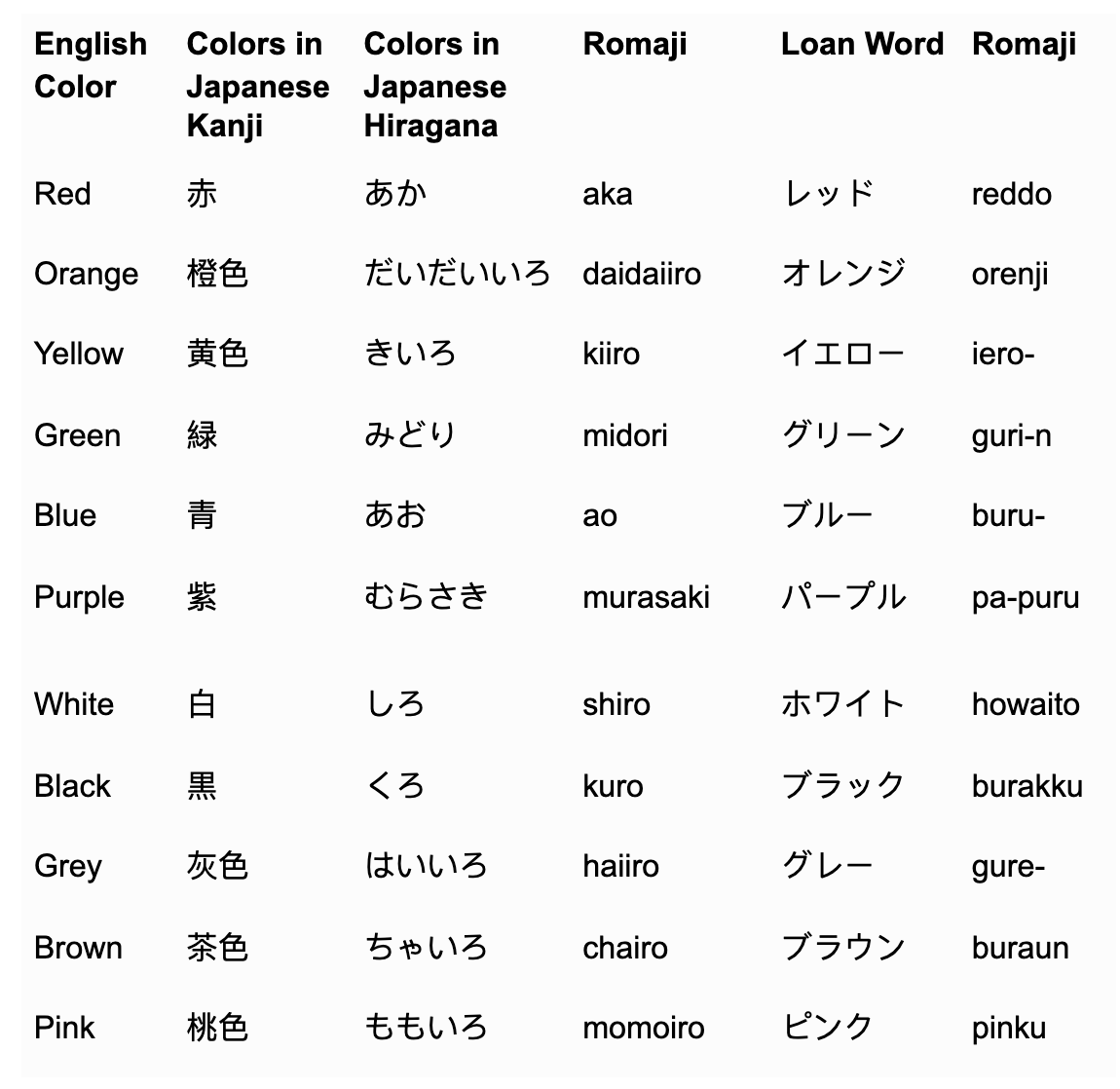Colors in Japanese are really confusing for beginners. Some color words are used differently. For example, the traffic light colors. The Japanese traffic light colors are red, yellow, and green. In the Japanese language, they are aka, Kanji character 赤 (red), ki (yellow), and ao (blue). However, the light colors are totally the same, but the green color name in Japanese is translated to blue. Really confusing, isn’t it?
Don’t worry, my eyes are okay - I’m not colorblind. When speaking in English, I say “Red, yellow and green.” I see the color as green, but we call it “blue” in Japanese.
The historical definition of Blue (ao) in Japanese colors
In the past, the Japanese had four basic color patterns: white, red, blue, and black. White described a clear figure, red described brightness, blue described a vague figure, and black described darkness. The word “blue” covered a big range, including blue and green. In some areas, old people used the word “blue” for yellow, green, blue-green, and violet-blue.
You might think that the Japanese have a weaker color sense and fewer names for colors. In reality, we have more than 460 colors in a traditional color chart that has been used for a long time. You can see for yourself on this traditional color chart.
Apparently, people in the past had a different classification for basic colors, and we still use the system for some words now, such as traffic lights. Other examples: Ao-ringo (literally blue apple), Ao-daikon (blue radish), and Ao-na (blue, leafy green vegetables) also use Blue (ao) for green colors.
In addition, blue also means fresh, immature, inexperienced, and unripe. If someone tells you, “You are still blue,” in Japanese, it means “You are still green (immature).” Since we use blue to cover the green shades, you would easily understand or guess the meaning.
Are there sexy colors in Japanese
Depending on the country, there are many colors that symbolize sexy images.
Can you guess what we mean by a pink movie in Japanese? It means a blue movie in English. In Japan, pink means something sexual. However, other countries use different colors for sexual images. For example, it’s green in Spain and yellow in China. White in France is used for the sexuality of naughty images.
Poor color in Kanji
The Kanji character 赤 (red) in Japanese is used for describing poverty, nothing, obviously and entirely.
Other examples:
赤貧(seki-hin)--extremely poor.
The first Kanji character describes entirely and the next one means poverty.
赤字(aka-ji) - deficit, red ink.
The second Kanji means a character/letter, so the literal translation is a red letter. It seems that this expression conveys the same idea in English--being in the red.
赤の他人(aka no tanin) - entirely unrelated person, utter stranger.
The literal translation is a red stranger.
Most of the Kanji characters have several sounds and images. It is one of the more interesting parts of the Japanese language.
Positive or negative colors in Japanese
Do most countries have the same or similar images for each color? What does yellow mean to you? In Japan, Singapore, and Australia, people have positive images for yellow, such as happiness and pleasure.
But, in England, yellow becomes a negative image, meaning uncomfortable or abnormal. Another negative meaning for yellow is in the United States where it’s used in an expression meaning chicken-hearted or cowardly.
Red or black tea, which colors to use in Japanese
I have lived in Thailand for more than three years, and I am still confused over some words. One of them is for tea. When ordering tea in restaurants, most of the nice restaurants have several choices for tea: English, Japanese, Chinese and original Thai. But, it also seems that they say black tea for English tea, green for Japanese tea, oolong for Chinese tea, and original Thai iced-milk for Thai tea.
When talking about English tea, the color black is not the same as when we talk about black coffee. And, we use the Kanji character 紅茶 for deep red tea in Japanese.
So I always imagine the red color and say “black tea” in English or Thai when ordering English tea in Thailand. By the way, original Thai tea has a very strong taste and a terra-cotta color because they use a lot of condensed milk, making it super sweet. After a hard day or working or studying, it can be a very good refreshment.
Japanese proverbs with colors
There are Japanese proverbs that contain words for color.
蜜柑が黄色くなると医者が青くなる( Mikan ga kiiroku naru to isha ga aoku naru. )
Literal translation: When Japanese oranges turn yellow, doctors become blue.
Meaning: The season when Japanese oranges ripen is the best climate for healthy living. This results in fewer patients so that doctors worry about losing their jobs and get pale faces.
We have four seasons, and each natural food has its own season. We call it “旬(shun) in Japanese. We believe that eating food in its season is the best time to eat it. Since ancient times, the Japanese have believed that autumn is the best season for staying healthy.
There is another proverb based on the same concept.
柿が赤くなれば医者が青くなる (kaki ga akaku nareba isha ga aoku naru)
Literal translation: When persimmons (orange-like fruit) turn red, doctors become blue.
Does your native language have any proverbs with colors? I’m really interested in learning the different meanings and images of colors in other languages. If you would like to share them with me, please contact me through italki or book a Japanese lesson with me!
Common Japanese color words

Final words
In this article, I mainly show you the Japanese color usage that is different from English. If you want to learn Japanese with a teacher or on your own, you need to spend much time on Japanese vocabulary, grammar, conversation, etc.







